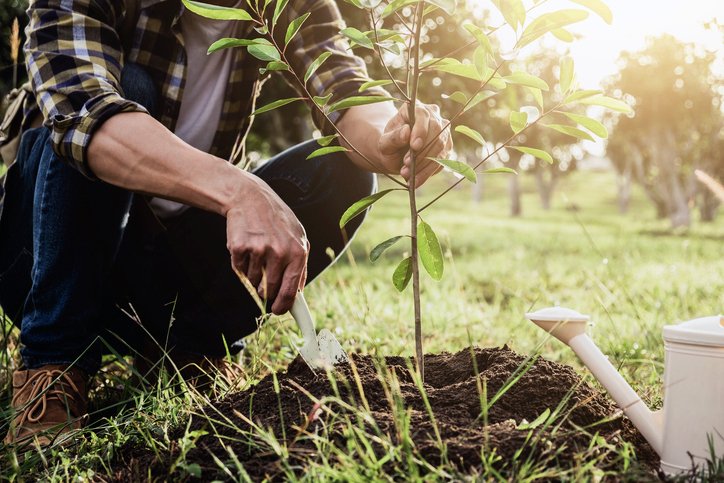Let’s get started planting trees.
First, think about the tree's purpose — shade, beauty, etc. — and the type of tree. Keep in mind your surroundings: power lines, house overhangs, garages, sidewalks and driveways, septic systems, and water lines.
Remember to look up and down. For example, a lacy oak might only grow 30-35 feet tall as opposed to the sugarberry tree, which can grow up to 80 feet in height and 3 feet in diameter.
At the nursery, double check with staff which species you have. Is it a crepe myrtle (30 feet) or dwarf crepe myrtle (3 feet)?
Now, let’s plant.
Select an appropriate location for the tree
Use a tree that will grow well under local environmental conditions and provide it with plenty of space to grow and mature. This includes both vertical and horizontal space for the canopy and plenty of room for root growth.
Dig the hole at least twice as wide as the root ball (wider is better)
Wide areas give roots a place to spread and grow. Dig the hole no deeper than the root ball to keep the tree from settling too deeply and dig square holes to allow for root penetration out of the hole and into the surrounding soil.
Fill the hole with water and check the drainage
If it takes longer than 24 hours to drain, select another site or another tree. A tree will die if its roots are under water for long periods of time. Tree roots need air.
Prune the tree sparingly and only if necessary
Remove dead, broken, and diseased branches and crushed and girdling roots only. Removing even a small portion of the healthy canopy actually slows root growth and delays establishment. A thoughtfully selected tree requires no pruning.
Remove all foreign materials from the tree
This includes wires, twine, cords, containers, tags, and especially non-biodegradable bags. If planting a balled and burlapped tree, remove as much of the burlap as possible to allow for water infiltration into the bag and root penetration out of the bag.
Set the tree in the hole with the root collar flush or slightly above natural grade
Planting too deeply is a leading cause of mortality of newly planted trees. Do not pick the tree up by the trunk. Always handle by the container or root ball.
Gently backfill with the same soil that came out of the hole
Create a natural environment, not an artificial one. Do not add soil amendments or fertilizer. Too much nitrogen will burn tender young roots, slowing growth and delaying establishment. Settle the soil with water. Tamping the soil causes compaction and damages roots.
Stake the tree only if necessary
Consult a professional if staking is required. Stakes should not be left in place longer than one year.
Mulch the trees out to the drip line, 2-3 inches deep and up to, but not touching, the trunk
Wood chips, pine bark, leaf litter, hay, etc., are great mulches. Mulch keeps soil temperature fluctuations to a minimum and increases soil moisture retention. Mulch also suppresses weed growth, and organic mulch adds nutrients to the soil.
Water the tree for at least one year, preferably two
A newly planted tree requires 6-8 gallons of water per diameter-inch of trunk per week. A thorough soaking is much better than light, frequent waterings. CEDAR FEVER
Back by popular demand: the recipe for cedar tea. Thanks to fellow former cedar fever sufferer Betty Branch, we can enjoy some relief from cedar fever.
Here is the recipe:
Place ½ cup of juniper berries in a saucepan with 1½ cups of water. Bring ingredients to a boil and then remove from the stove, cover, and let cool. Transfer the tea and the berries into a jar and place in the refrigerator.
By the way, if you do not have enough berries on your place, they are available at local health food stores (or stop and ask any rancher if they would mind you harvesting their berries). In case you are new to Texas, we always ask permission first.
Each morning, take one teaspoon of the tea. Presto, you will have no more allergies to Ashe juniper for this season, and, after doing this annually, at some time in the future, you will eventually become immune. In a pinch, we do eat them straight off the tree.
Warning: Please consult your physician before trying this homeopathic remedy as some folks are highly allergic to Ashe juniper.
Thanks again, Betty!
Until next time, keep your souls and soles in your garden!
Remember the True Master Gardener: Jesus said, “I am the vine; my Father is the Gardener.” John 15:1
Call Bill Luedecke at The Luedecke Group Realtors at 512-577-1463 or email him at bill@texasland.net. Contact Martelle Luedecke at 512-769-3179 or luedeckephotography@gmail.com.

